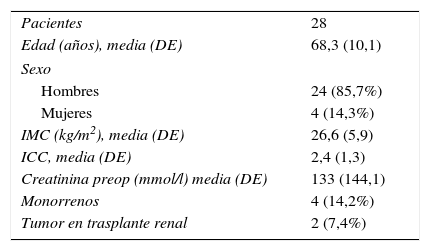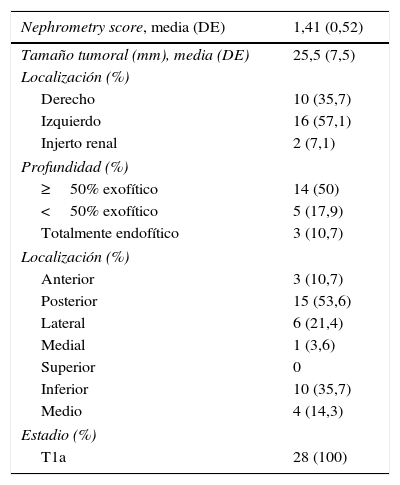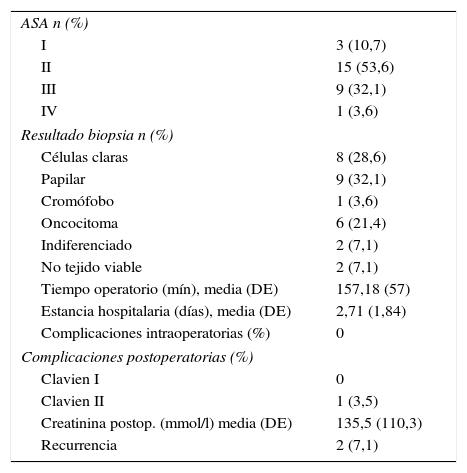Evaluar la efectividad técnica y oncológica de la crioterapia renal percutánea (CP) ecoguiada en un grupo seleccionado de pacientes con tumor renal.
Material y métodosSe realizó un estudio prospectivo de 28 pacientes con tumores renales T1a de cara posterior y de borde externo medio e inferior. A todos se les realizó CP ecoguiada. El seguimiento fue con TC al mes y después cada 6 meses, considerándose como criterio de buen resultado la ausencia total de incorporación de contraste. Realizamos un estudio descriptivo y de supervivencia mediante Kaplan-Meier.
ResultadosSe trata de 28 pacientes con una edad media (DE) de 68,3 (10,1) años, en los que se realizaron 28 procedimientos. La media (DE) de tamaño fue de 25,5mm (7,5) nephrometry score 1,41 (0,52) y creatinina preoperatoria 133,5mmol/l (144,1). No hubo ninguna complicación intraoperatoria. Como complicaciones postoperatorias solo un caso (3,5%) de lesión cutánea al tratar un tumor en riñón trasplantado (Clavien II). La mediana de seguimiento fue de 25 meses, y la creatinina media (DE) postoperatoria fue de 135,5mmol/l (110,3). Presentaron recurrencia radiológica 2 casos (eficacia del 93%), con un tiempo medio hasta la recurrencia de 12 y 19 meses respectivamente. No se produjo ninguna muerte relacionada con el tumor.
ConclusionesNuestra serie, hasta el momento la más larga de CP en nuestro país, muestra que con una adecuada selección de tumores la CP es una técnica segura y con mínima morbilidad. La ecografía permite realizar el procedimiento de forma controlada, además de ahorrar irradiación y costes.
To evaluate the technical and oncological effectiveness of ultrasound-guided percutaneous renal cryotherapy (PRC) in a selected group of patients with renal cancer.
Material and methodsWe conducted a prospective study of 28 patients with posterior-facing T1a renal tumors with middle and inferior external borders. All patients underwent ultrasound-guided PRC. Follow-up was conducted with computed tomography at 1 month and then every 6 months, with a good result defined as the total absence of contrast incorporation. We performed a descriptive and survival study using the Kaplan-Meier estimator.
ResultsThe 28 patients had a mean age (SD) of 68.3 (10.1) years, and the group underwent 28 procedures. The mean (SD) size of the tumors was 25.5 (7.5) mm, the mean nephrometry score was 1.41 (0.52) and the mean preoperative creatinine level was 133.5 (144.1) mmol/L. There were no intraoperative complications. In terms of postoperative complications, there was only 1 case (3.5%) of a skin lesion resulting from treating a tumor in a transplanted kidney (Clavien II). The median follow-up was 25 months, and the mean (SD) postoperative creatinine level was 135.5 (110.3) mmol/L. Two cases presented radiological recurrence (93% efficacy), with a mean time to recurrence of 12 and 19 months, respectively. There were no tumor-related deaths.
ConclusionsOur series (the largest on PRC in our country to date) shows that, with an appropriate selection of tumors, PRC is a safe technique with minimal morbidity. Ultrasonography enables the controlled performance of the procedure and saves the patient from radiation and reduces costs.
Artículo
Comprando el artículo el PDF del mismo podrá ser descargado
Precio 19,34 €
Comprar ahora













